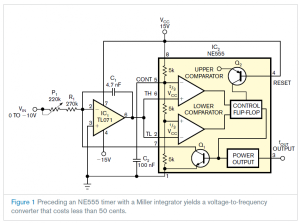Summary of NE555 timer sparks low-cost voltage-to-frequency converter
The article describes a low-cost voltage-to-frequency converter circuit using the NE555 timer and a TL071 operational amplifier. The circuit converts an input voltage range of 0 to –10V into an output frequency from 0 to 1000 Hz. The NE555 timer discharges a capacitor when its voltage reaches two-thirds of VCC, creating a pulse frequency proportional to the input voltage. A resistor and potentiometer (P1) calibrate the output frequency. The design offers an economical solution for voltage-to-frequency conversion, though accuracy declines at higher frequencies due to fixed discharge time.
Parts used in the Voltage-to-Frequency Converter Project:
- NE555 timer IC
- TL071 operational amplifier
- Capacitor C1
- Potentiometer P1
- Resistor R1
- Power supply (VCC)
In 1971, Signetics—later Philips—introduced the NE555 timer, and manufacturers are still producing more than 1 billion of them a year. By adding a few components to the NE555, you can build a simple voltage-to-frequency converter for less than 50 cents. The circuit contains a Miller integrator based on a TL071 along with an NE555 timer (Figure 1). The input voltage in this application ranges from 0 to –10V, yielding an output-frequency range of 0 to 1000 Hz. The current of C1 is the function of input voltage: IC=–VIN/(P1+R1).
As the voltage on C1 reaches two-thirds of VCC, the 555’s internal discharge transistor opens, and the voltage on C1 returns to one-third the voltage of VCC, the lower comparator threshold. At one-third this voltage, the discharge transistor switches off, and C1 again starts charging. The NE555’s output is high while C1 is charging and low while C1 is discharging. The product of the input voltage and the charging time of C1 is constant. Because the discharge time is shorter than the charging time, the following equation results for the output frequency: fOUT~VIN/(P1+R1)×C1×1/3VCC.
P1 calibrates the relationship between the output frequency and the input voltage. Because the discharge interval is approximately 30 µsec, the accuracy of the voltage-to-frequency conversion decreases as the frequency increases.
For More Details: NE555 timer sparks low-cost voltage-to-frequency converter

